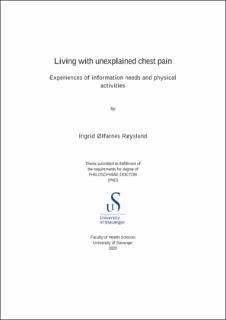| dc.contributor.advisor | Dysvik, Elin | |
| dc.contributor.advisor | Furnes, Bodil | |
| dc.contributor.advisor | Friberg, Febe | |
| dc.contributor.advisor | Bru, Lars Edvin | |
| dc.contributor.advisor | Larsen, Alf-Inge | |
| dc.contributor.author | Røysland, Ingrid Ølfarnes | |
| dc.date.accessioned | 2020-09-28T10:10:40Z | |
| dc.date.available | 2020-09-28T10:10:40Z | |
| dc.date.issued | 2020-03 | |
| dc.identifier.citation | Living with unexplained chest pain: Experiences of information needs and physical activities by Ingrid Ølfarnes Røysland. Stavanger : University of Stavanger, 2020 (PhD thesis UiS 481) | en_US |
| dc.identifier.isbn | 978-82-7644-876-4 | |
| dc.identifier.issn | 1890-1387 | |
| dc.identifier.uri | https://hdl.handle.net/11250/2679925 | |
| dc.description.abstract | Background: Unexplained chest pain is a common condition in medical settings. A large number of these patients will continue to suffer from chest pain after medical examination with negative findings. Unexplained chest pain covers many possible complaints, as there are a number of possible factors that can contribute to the condition. To meet patients’ expectations, health professionals need to know more about experiences in relation to the information needs of patients with unexplained chest pain. Physical activity is recommended. At the same time, physical activity is one of the major avoidance behaviours in patients with coronary heart disease. There is a need for understanding of experiences of living with unexplained chest pain.
Aim: The overall aim of this thesis was to explore and describe experiences related to living with unexplained chest pain. This has been carried out in three steps. The specific aim in step I was to explore the information needs of patients with unexplained chest pain, and how these needs were met by health professionals during medical consultations in a cardiological outpatient clinic. On the basis of the interviews in step I, the specific aim in step II therefore was to achieve increased understanding of the meaning of physical activity in daily life for people with unexplained chest pain. Step III was an extension, explaining the transitional process people with unexplained chest pain undergo while participating in exercise training over time.
Method: A descriptive and explorative design was used. Three studies with different qualitative methodological approaches were performed, which remained separate during the analysis phase. Study I has an inductive design, and content analysis was performed in regard to the information needs of patients with unexplained chest pain (Graneheim & Lundman, 2004). Study II has an inductive design with a phenomenological hermeneutic approach (Lindseth & Norberg, 2004).
Study III has an inductive design to collect and analyze qualitative data that aims to develop theories grounded in real-world observations (Strauss & Glaser, 1967; Glaser, 1978).
Results: Study I described the uncertainty as exploring the information needs of patients with unexplained chest pain. Uncertainty emerged from unanswered questions, as well as experiencing lack of focus on individual problems. Additional aspects of uncertainty related to physical activity were also revealed. In Study II, an existential uncertainty related to the chest pain and physical activity was identified. The results were interpreted as a balancing act between existential uncertainty and certainty. In Study III, patients participated in a high intensity exercise programme. A transitional process was revealed, whereby vulnerability was confronted under safe and supportive conditions. Through this process, patients had to balance their existential uncertainty.
Conclusion: A special focus must be complemented with the inclusion of a person-centered approach to meet patients’ beliefs, perceptions and expressions of feelings related to experiencing unexplained chest pain. For health professionals, there are revealed challenges in understanding the vulnerability in people balancing between existential uncertainty and certainty in connection with doing or avoiding physical activity while living with unexplained chest pain. The transition while participating in a high intensity exercise training programme was described as a process of becoming more capable. This training can be understood as experiences that change the understanding of what the person in question can and dares to do. | en_US |
| dc.language.iso | eng | en_US |
| dc.publisher | Stavanger: Universitetet i Stavanger | en_US |
| dc.relation.ispartofseries | PhD thesis UiS;481 | |
| dc.relation.haspart | Paper 1: Røysland, I.Ø., Dysvik, E., Furnes, B., Friberg, F. (2013) Exploring the information needs of patients with unexplained chest pain. Patient Preference and Adherence, 7, pp. 915—923. https://doi.org/10.2147/PPA.S47120 | en_US |
| dc.relation.haspart | Paper 2: Røysland, I.Ø., Friberg, F. (2016) Unexplained Chest Pain and Physical Activity: Balancing between Existential Uncertainty and Certainty. Qualitative Health Research, 26(2), pp. 215-226. https://doi.org/10.1177/1049732315570129. This paper is not in Brage for copyright reasons. | en_US |
| dc.relation.haspart | Paper 3: Røysland, I.Ø., Friberg, F., Brinchman, B.S. et al. (2017) Confronting one's vulnerability - patients with chest pain participating in a high intensity exercise program. Journal of Clinical Nursing, 26(13-14), 2006-2015 | en_US |
| dc.rights | Navngivelse 4.0 Internasjonal | * |
| dc.rights.uri | http://creativecommons.org/licenses/by/4.0/deed.no | * |
| dc.subject | brystsmerter | en_US |
| dc.subject | chest pain | en_US |
| dc.subject | fysisk aktivitet | en_US |
| dc.subject | informasjonsbehov | en_US |
| dc.title | Living with unexplained chest pain: Experiences of information needs and physical activities | en_US |
| dc.type | Doctoral thesis | en_US |
| dc.rights.holder | © 2020 Ingrid Ølfarnes Røysland | en_US |
| dc.subject.nsi | VDP::Medisinske Fag: 700 | en_US |

